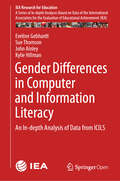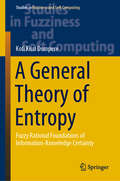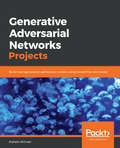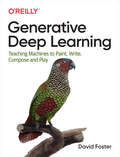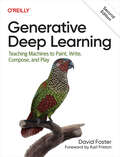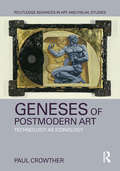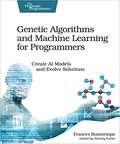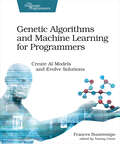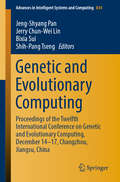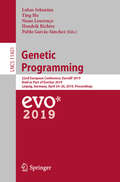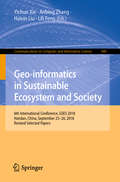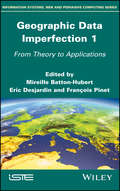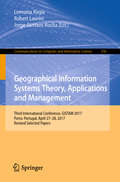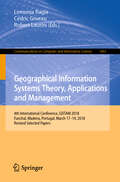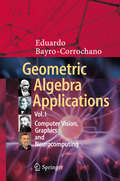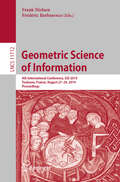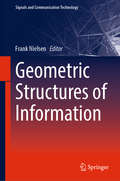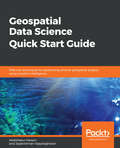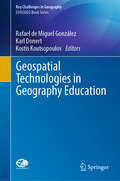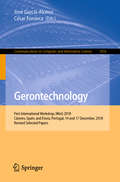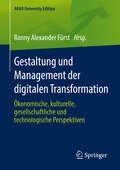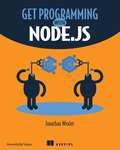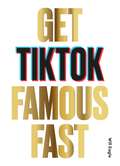- Table View
- List View
Gender Differences in Computer and Information Literacy: An In-depth Analysis of Data from ICILS (IEA Research for Education #8)
by Eveline Gebhardt Sue Thomson John Ainley Kylie HillmanThis open access book presents a systematic investigation into internationally comparable data gathered in ICILS 2013. It identifies differences in female and male students’ use of, perceptions about, and proficiency in using computer technologies. Teachers’ use of computers, and their perceptions regarding the benefits of computer use in education, are also analyzed by gender. When computer technology was first introduced in schools, there was a prevailing belief that information and communication technologies were ‘boys’ toys’; boys were assumed to have more positive attitudes toward using computer technologies. As computer technologies have become more established throughout societies, gender gaps in students’ computer and information literacy appear to be closing, although studies into gender differences remain sparse. The IEA’s International Computer and Information Literacy Study (ICILS) is designed to discover how well students are prepared for study, work, and life in the digital age. Despite popular beliefs, a critical finding of ICILS 2013 was that internationally girls tended to score more highly than boys, so why are girls still not entering technology-based careers to the same extent as boys? Readers will learn how male and female students differ in their computer literacy (both general and specialized) and use of computer technology, and how the perceptions held about those technologies vary by gender.
A General Theory of Entropy: Fuzzy Rational Foundations of Information-Knowledge Certainty (Studies in Fuzziness and Soft Computing #384)
by Kofi Kissi DompereThis book presents an epistemic framework for dealing with information-knowledge and certainty-uncertainty problems within the space of quality-quantity dualities. It bridges between theoretical concepts of entropy and entropy measurements, proposing the concept and measurement of fuzzy-stochastic entropy that is applicable to all areas of knowing under human cognitive limitations over the epistemological space. The book builds on two previous monographs by the same author concerning theories of info-statics and info-dynamics, to deal with identification and transformation problems respectively. The theoretical framework is developed by using the toolboxes such as those of the principle of opposites, systems of actual-potential polarities and negative-positive dualities, under different cost-benefit time-structures. The category theory and the fuzzy paradigm of thought, under methodological constructionism-reductionism duality, are used in the fuzzy-stochastic and cost-benefit spaces to point to directions of global application in knowing, knowledge and decision-choice actions. Thus, the book is concerned with a general theory of entropy, showing how the fuzzy paradigm of thought is developed to deal with the problems of qualitative-quantitative uncertainties over the fuzzy-stochastic space, which will be applicable to conditions of soft-hard data, fact, evidence and knowledge over the spaces of problem-solution dualities, decision-choice actions in sciences, non-sciences, engineering and planning sciences to abstract acceptable information-knowledge elements.
Generative Adversarial Networks Projects: Build next-generation generative models using TensorFlow and Keras
by Kailash AhirwarThis book is intended for data scientists, machine learning developers, deep learning practitioners and AI enthusiasts who want a project guide to test their knowledge and expertise in building real-world GANs models. These full-fledged projects will help you master machine learning, and neural network principles. Basic understanding of machine learning and deep learning concepts will be handy. Hands-on experience in Tensorflow or Keras will be a plus point
Generative Deep Learning: Teaching Machines to Paint, Write, Compose, and Play
by David FosterGenerative modeling is one of the hottest topics in AI. It’s now possible to teach a machine to excel at human endeavors such as painting, writing, and composing music. With this practical book, machine-learning engineers and data scientists will discover how to re-create some of the most impressive examples of generative deep learning models, such as variational autoencoders, generative adversarial networks (GANs), encoder-decoder models and world models.Author David Foster demonstrates the inner workings of each technique, starting with the basics of deep learning before advancing to some of the most cutting-edge algorithms in the field. Through tips and tricks, you’ll understand how to make your models learn more efficiently and become more creative. Discover how variational autoencoders can change facial expressions in photos; Build practical GAN examples from scratch, including CycleGAN for style transfer and MuseGAN for music generation; Create recurrent generative models for text generation and learn how to improve the models using attention; Understand how generative models can help agents to accomplish tasks within a reinforcement learning setting; Explore the architecture of the Transformer (BERT, GPT-2) and image generation models such as ProGAN and StyleGAN.
Generative Deep Learning: Teaching Machines To Paint, Write, Compose, And Play
by David FosterGenerative AI is the hottest topic in tech. This practical book teaches machine learning engineers and data scientists how to use TensorFlow and Keras to create impressive generative deep learning models from scratch, including variational autoencoders (VAEs), generative adversarial networks (GANs), Transformers, normalizing flows, energy-based models, and denoising diffusion models.The book starts with the basics of deep learning and progresses to cutting-edge architectures. Through tips and tricks, you'll understand how to make your models learn more efficiently and become more creative.Discover how VAEs can change facial expressions in photosTrain GANs to generate images based on your own datasetBuild diffusion models to produce new varieties of flowersTrain your own GPT for text generationLearn how large language models like ChatGPT are trainedExplore state-of-the-art architectures such as StyleGAN2 and ViT-VQGANCompose polyphonic music using Transformers and MuseGANUnderstand how generative world models can solve reinforcement learning tasksDive into multimodal models such as DALL.E 2, Imagen, and Stable DiffusionThis book also explores the future of generative AI and how individuals and companies can proactively begin to leverage this remarkable new technology to create competitive advantage.
Geneses of Postmodern Art: Technology As Iconology (Routledge Advances in Art and Visual Studies)
by Paul CrowtherPostmodernism in the visual arts is not just another 'ism.' It emerged in the 1960s as a transformation of artistic creativity inspired by Duchamp's idea that the artwork does not have to be physically made by its creator. Products of mass culture and technology can be used just as well as traditional media. This idea became influential because of a widespread naturalization of technology - where technology becomes something lived in as well as used. Postmodern art embodies this attitude. To explain why, Paul Crowther investigates topics such as eclecticism, the sublime, deconstruction in art and philosophy, and Paolozzi's Wittgenstein-inspired works.
Genetic Algorithms and Machine Learning for Programmers: Create AI Models and Evolve Solutions
by Frances BuontempoSelf-driving cars, natural language recognition, and online recommendation engines are all possible thanks to Machine Learning. Now you can create your own genetic algorithms, nature-inspired swarms, Monte Carlo simulations, cellular automata, and clusters. Learn how to test your ML code and dive into even more advanced topics. If you are a beginner-to-intermediate programmer keen to understand machine learning, this book is for you. <P><P> Discover machine learning algorithms using a handful of self-contained recipes. Build a repertoire of algorithms, discovering terms and approaches that apply generally. Bake intelligence into your algorithms, guiding them to discover good solutions to problems.
Genetic Algorithms and Machine Learning for Programmers
by Frances BuontempoSelf-driving cars, natural language recognition, and online recommendation engines are all possible thanks to Machine Learning. Now you can create your own genetic algorithms, nature-inspired swarms, Monte Carlo simulations, cellular automata, and clusters. Learn how to test your ML code and dive into even more advanced topics. If you are a beginner-to-intermediate programmer keen to understand machine learning, this book is for you. Discover machine learning algorithms using a handful of self-contained recipes. Build a repertoire of algorithms, discovering terms and approaches that apply generally. Bake intelligence into your algorithms, guiding them to discover good solutions to problems. In this book, you will: Use heuristics and design fitness functions.Build genetic algorithms.Make nature-inspired swarms with ants, bees and particles.Create Monte Carlo simulations.Investigate cellular automata.Find minima and maxima, using hill climbing and simulated annealing.Try selection methods, including tournament and roulette wheels.Learn about heuristics, fitness functions, metrics, and clusters. Test your code and get inspired to try new problems. Work through scenarios to code your way out of a paper bag; an important skill for any competent programmer. See how the algorithms explore and learn by creating visualizations of each problem. Get inspired to design your own machine learning projects and become familiar with the jargon. What You Need: Code in C++ (>= C++11), Python (2.x or 3.x) and JavaScript (using the HTML5 canvas). Also uses matplotlib and some open source libraries, including SFML, Catch and Cosmic-Ray. These plotting and testing libraries are not required but their use will give you a fuller experience. Armed with just a text editor and compiler/interpreter for your language of choice you can still code along from the general algorithm descriptions.
Genetic and Evolutionary Computing: Proceedings of the Twelfth International Conference on Genetic and Evolutionary Computing, December 14-17, Changzhou, Jiangsu, China (Advances in Intelligent Systems and Computing #834)
by Jeng-Shyang Pan Jerry Chun-Wei Lin Bixia Sui Shih-Pang TsengThis volume of Advances in Intelligent Systems and Computing highlights papers presented at the 12th International Conference on Genetic and Evolutionary Computing (ICGEC 2018). Held from 14 to 17 December 2018 in Changzhou, Jiangsu, China, the conference was co-sponsored by Springer, Changzhou College of Information Technology, Fujian Provincial Key Lab of Big Data Mining and Applications, Fujian University of Technology, National Demonstration Center for Experimental Electronic Information and Electrical Technology Education, Fujian University of Technology, Tajen University, National University of Kaohsiung, and Shandong University of Science and Technology, China. The conference is intended as an international forum for the researchers and professionals in all areas of genetic and evolutionary computing.
Genetic Programming: 22nd European Conference, EuroGP 2019, Held as Part of EvoStar 2019, Leipzig, Germany, April 24–26, 2019, Proceedings (Lecture Notes in Computer Science #11451)
by Lukas Sekanina Ting Hu Nuno Lourenço Hendrik Richter Pablo García-SánchezThis book constitutes the refereed proceedings of the 22nd European Conference on Genetic Programming, EuroGP 2019, held as part of Evo* 2019, in Leipzig, Germany, in April 2019, co-located with the Evo* events EvoCOP, EvoMUSART, and EvoApplications. The 12 revised full papers and 6 short papers presented in this volume were carefully reviewed and selected from 36 submissions. They cover a wide range of topics and reflect the current state of research in the field. With a special focus on real-world applications in 2019, the papers are devoted to topics such as the test data design in software engineering, fault detection and classification of induction motors, digital circuit design, mosquito abundance prediction, machine learning and cryptographic function design.
Geo-informatics in Sustainable Ecosystem and Society: 6th International Conference, GSES 2018, Handan, China, September 25–26, 2018, Revised Selected Papers (Communications in Computer and Information Science #980)
by Yichun Xie Anbing Zhang Haixin Liu Lili FengThis book constitutes the refereed proceedings of the 6th International Conference on Geo-informatics in Sustainable Ecosystem and Society, GSES 2018, held in Handan, China, in September 2018. The 46 papers presented in this volume were carefully reviewed and selected from 153 submissions and focus on spatial data acquisition, processing and management, modeling and analysis, and recent applications in the context of building healthier ecology and resource management using advanced remote sensing technology and spatial data modeling and analysis.
Geographical Data Imperfection 1: From Theory to Applications
by Mireille Batton-Hubert Eric Desjardin François PinetGeomatics is a field of science that has been intimately intertwined with our daily lives for almost 30 years, to the point where we often forget all the challenges it entails. Who does not have a navigation application on their phone or regularly engage with geolocated data? What is more, in the coming decades, the accumulation of geo-referenced data is expected to increase significantly. This book focuses on the notion of the imperfection of geographic data, an important topic in geomatics. It is essential to be able to define and represent the imperfections that are encountered in geographical data. Ignoring these imperfections can lead to many risks, for example in the use of maps which may be rendered inaccurate. It is, therefore, essential to know how to model and treat the different categories of imperfection. A better awareness of these imperfections will improve the analysis and the use of this type of data.
Geographical Information Systems Theory, Applications and Management (Communications in Computer and Information Science #936)
by Lemonia Ragia Robert Laurini Jorge Gustavo RochaThis book constitutes extended, revised and selected contributions from the Second International Conference on Geographical Information Systems Theory, Applications and Management, GISTAM 2016, held in Rome, Italy, in April 2016. The 10 papers presented in this volume were carefully reviewed and selected from a total of 33 submissions. They contribute to the understanding of relevant trends of current research on the topic, including urban and regional planning; water information systems; geospatial information and technologies; spatio-temporal database management; decision support systems; energy information systems; GPS, and location detection.
Geographical Information Systems Theory, Applications and Management: 4th International Conference, GISTAM 2018, Funchal, Madeira, Portugal, March 17–19, 2018, Revised Selected Papers (Communications in Computer and Information Science #1061)
by Lemonia Ragia Cédric Grueau Robert LauriniThis book constitutes the thoroughly refereed proceedings of the 4th International Conference on Geographical Information Systems Theory, Applications and Management, GISTAM 2018, held in Funchal, Madeira, Portugal, in March 2018.The 7 revised full papers presented were carefully reviewed and selected from 58 submissions. The papers are centered on urban and regional planning; water information systems; geospatial information and technologies; spatio-temporal database management; decision support systems; energy information systems; GPS and location detection.
Geometric Algebra Applications Vol. I: Computer Vision, Graphics and Neurocomputing
by Eduardo Bayro-CorrochanoThe goal of the Volume I Geometric Algebra for Computer Vision, Graphics and Neural Computing is to present a unified mathematical treatment of diverse problems in the general domain of artificial intelligence and associated fields using Clifford, or geometric, algebra.Geometric algebra provides a rich and general mathematical framework for Geometric Cybernetics in order to develop solutions, concepts and computer algorithms without losing geometric insight of the problem in question. Current mathematical subjects can be treated in an unified manner without abandoning the mathematical system of geometric algebra for instance: multilinear algebra, projective and affine geometry, calculus on manifolds, Riemann geometry, the representation of Lie algebras and Lie groups using bivector algebras and conformal geometry. By treating a wide spectrum of problems in a common language, this Volume I offers both new insights and new solutions that should be useful to scientists, and engineers working in different areas related with the development and building of intelligent machines. Each chapter is written in accessible terms accompanied by numerous examples, figures and a complementary appendix on Clifford algebras, all to clarify the theory and the crucial aspects of the application of geometric algebra to problems in graphics engineering, image processing, pattern recognition, computer vision, machine learning, neural computing and cognitive systems.
Geometric Science of Information: 4th International Conference, GSI 2019, Toulouse, France, August 27–29, 2019, Proceedings (Lecture Notes in Computer Science #11712)
by Frank Nielsen Frédéric BarbarescoThis book constitutes the proceedings of the 4th International Conference on Geometric Science of Information, GSI 2019, held in Toulouse, France, in August 2019.The 79 full papers presented in this volume were carefully reviewed and selected from 105 submissions. They cover all the main topics and highlights in the domain of geometric science of information, including information geometry manifolds of structured data/information and their advanced applications.
Geometric Structures of Information (Signals and Communication Technology)
by Frank NielsenThis book focuses on information geometry manifolds of structured data/information and their advanced applications featuring new and fruitful interactions between several branches of science: information science, mathematics and physics. It addresses interrelations between different mathematical domains like shape spaces, probability/optimization & algorithms on manifolds, relational and discrete metric spaces, computational and Hessian information geometry, algebraic/infinite dimensional/Banach information manifolds, divergence geometry, tensor-valued morphology, optimal transport theory, manifold & topology learning, and applications like geometries of audio-processing, inverse problems and signal processing. The book collects the most important contributions to the conference GSI’2017 – Geometric Science of Information.
Geospatial Data Science Quick Start Guide: Effective techniques for performing smarter geospatial analysis using location intelligence
by Jayakrishnan Vijayaraghavan Abdishakur HassanDiscover the power of location data to build effective, intelligent data models with Geospatial ecosystemsKey FeaturesManipulate location-based data and create intelligent geospatial data modelsBuild effective location recommendation systems used by popular companies such as UberA hands-on guide to help you consume spatial data and parallelize GIS operations effectivelyBook DescriptionData scientists, who have access to vast data streams, are a bit myopic when it comes to intrinsic and extrinsic location-based data and are missing out on the intelligence it can provide to their models. This book demonstrates effective techniques for using the power of data science and geospatial intelligence to build effective, intelligent data models that make use of location-based data to give useful predictions and analyses.This book begins with a quick overview of the fundamentals of location-based data and how techniques such as Exploratory Data Analysis can be applied to it. We then delve into spatial operations such as computing distances, areas, extents, centroids, buffer polygons, intersecting geometries, geocoding, and more, which adds additional context to location data. Moving ahead, you will learn how to quickly build and deploy a geo-fencing system using Python. Lastly, you will learn how to leverage geospatial analysis techniques in popular recommendation systems such as collaborative filtering and location-based recommendations, and more.By the end of the book, you will be a rockstar when it comes to performing geospatial analysis with ease.What you will learnLearn how companies now use location dataSet up your Python environment and install Python geospatial packagesVisualize spatial data as graphsExtract geometry from spatial dataPerform spatial regression from scratchBuild web applications which dynamically references geospatial dataWho this book is forData Scientists who would like to leverage location-based data and want to use location-based intelligence in their data models will find this book useful. This book is also for GIS developers who wish to incorporate data analysis in their projects. Knowledge of Python programming and some basic understanding of data analysis are all you need to get the most out of this book.
Geospatial Technologies in Geography Education (Key Challenges in Geography)
by Rafael de Miguel González Karl Donert Kostis KoutsopoulosThis book addresses new pedagogies focusing on the use of geospatial technologies and geomedia in the classroom. Today, geospatial technologies are substantially influencing geography teaching and learning, particularly in secondary education. Web-GIS, virtual globes, storytelling, maps and apps for mobile devices are transforming the nature and design of geography curricula, instructional processes, didactics, resources and assessments. Undoubtedly, geography is among those school subjects that have benefited most from the implementation of new technologies in the classroom. Geospatial technologies can be used to develop inquiry-based learning or project-based learning pedagogies and help students to acquire spatial reasoning and spatial citizenship skills in the context of education for sustainable development.This book highlights a range of initiatives, projects and educational practices – from several European countries and settings – related to geospatial challenges in geography education. Given its scope, it will be equally appealing to scientists, students and teachers of geography and other fields using geospatial technologies and geomedia.
Gerontechnology: First International Workshop, IWoG 2018, Cáceres, Spain, and Évora, Portugal, 14 and 17 December, 2018, Revised Selected Papers (Communications in Computer and Information Science #1016)
by José García-Alonso César FonsecaThis book constitutes the thoroughly refereed post-conference proceedings of the First International Workshop on Gerotechnology, IWoG 2018, held in Cáceres, Spain on December 14, 2018, and in Évora, Portugal, on December 17, 2018. The 24 revised full papers along with 8 short papers presented were carefully reviewed and selected from 71 submissions.The papers are organized in topical sections on knowledge management for health: context, cognition, behavior and user modeling; technologies to increase the quality of life of the elderly population; Internet of Things (IoT); smarts technologies and algorithms for health; monitoring and management of chronic and non-chronic diseases;solutions for active aging, social integration and self-care; health interventions to support caregivers of elderly people; public health initiatives.
Gestaltung und Management der digitalen Transformation: Ökonomische, kulturelle, gesellschaftliche und technologische Perspektiven (AKAD University Edition)
by Ronny Alexander FürstDie Digitalisierung und der sich exponentiell entwickelnde technologische Fortschritt bahnen sich ihren Weg in alle Lebensbereiche einer globalisierten Welt - scheinbar völlig ungeachtet davon, wie dies von einzelnen Individuen und Gesellschaften wahrgenommen und bewertet wird. Manche fühlen sich als Verlierer und haben Ängste, von Robotern und künstlicher Intelligenz ersetzt zu werden, andere entdecken in der Zeitenwende neue Chancen und Perspektiven. Dies wirft zu den technologischen und ökonomischen Herausforderungen der digitalen Transformation zusätzliche kulturelle und gesellschaftliche Fragen auf. Beim 9. AKAD Forum der AKAD University diskutierten Wissenschaftler und Top-Manager das Leitthema „Digitale Transformation = soziale Revolution?“ In diesem Buch werden nun die Fachbeiträge der Experten aus Wirtschaft, Technik, Philosophie und Sprachwissenschaften einem breiteren Publikum vorgestellt. Nach einer theoretischen und praktischen Standortbestimmung werden Konzepte zum Management der digitalen Transformation aufgezeigt, durch die Digitalisierung induzierte soziale Entwicklungen diskutiert und der erforderliche Kompetenzwandel in der digitalen Arbeitswelt sowie neue Anforderungen an die Personalentwicklung beleuchtet und abschließend Zukunftsperspektiven abgeleitet. Lesenswert für alle, die die digitale Transformation verstehen und aktiv gestalten wollen!„Dieses Buch zeigt, wie es Unternehmen gelingt, ihre Geschäftsmodelle auf die digitale Zukunft vorzubereiten und wie dadurch Wettbewerbsvorteile geschaffen und Kunden-Anforderungen besser erfüllt werden können. Die theoretische Fundierung kombiniert mit vielen konkreten, praktischen Hinweisen und Fallbeispielen macht das Buch gleichermaßen lesenswert und nutzbar für Wissenschaftler und Praktiker aus unterschiedlichsten Branchen.“ Bernd Hake, Vorstand Hugo Boss AG
Get a Job, Creep: The Creeper Diaries, An Unofficial Minecrafters Novel, Book Ten (The Creeper Diaries #10)
by Greyson MannWhen Gerald’s parents decide it’s time for him to learn the value of an emerald, he sets out to get the perfect summer job. Wolf-walking, anyone? Baby-zombie-sitting? Llama grooming? Gerald isn’t exactly loving his options. When his mom starts selling vitamins and minerals, Gerald comes up with a sales idea of his own—a BIG idea. But he’s going to need some help. After he hires a few friends, they start raking in the emeralds. Gerald is going to be rich! He can see it already! But his fortune might come with a pretty big price tag, too.
Get Programming with Node.js
by Jonathan WexlerSummary Get Programming with Node.js teaches you to build web servers using JavaScript and Node. In this engaging tutorial, you'll work through eight complete projects, from writing the code for your first web server to adding live chat to a web app. Your hands will stay on the keyboard as you explore the most important aspects of the Node development process, including security, database management, authenticating user accounts, and deploying to production. You'll especially appreciate the easy-to-follow discussions, illuminating diagrams, and carefully explained code! Purchase of the print book includes a free eBook in PDF, Kindle, and ePub formats from Manning Publications. About the Technology Node.js delivers the speed and reliability you need for ecommerce, social media, and gaming applications. It comes with thousands of prebuilt packages to help you get started immediately. If you want to use JavaScript on the server, Node.js is your choice. What's inside New features from ES2015 and later Writing asynchronous code Creating data models Debugging JavaScript modules About the Reader Written for front-end web developers with intermediate JavaScript skills. Table of Contents GETTING SET UP Lesson 0 - Setting up Node.js and the JavaScript engine Lesson 1 - Configuring your environment Lesson 2 - Running a Node.js application UNIT 1 - GETTING STARTED WITH NODE.JS Lesson 3 - Creating a Node.js module Lesson 4 - Building a simple web server in Node.js Lesson 5 - Handling incoming data Lesson 6 - Writing better routes and serving external files Lesson 7 - Capstone: Creating your first web application UNIT 2 - EASIER WEB DEVELOPMENT WITH EXPRESS.JS Lesson 8 - Setting up an app with Express.js Lesson 9 - Routing in Express.js Lesson 10 - Connecting views with templates Lesson 11 - Configurations and error handling Lesson 12 - Capstone: Enhancing the Confetti Cuisine site with Express.js UNIT 3 - CONNECTING TO A DATABASE Lesson 13 - Setting up a MongoDB database Lssson 14 - Building models with Mongoose Lesson 15 - Connecting controllers and models Using promises with Mongoose Lesson 16 - Capstone: Saving user subscriptions UNIT 4 - BUILDING A USER MODEL Lesson 17 - Improving your data models Lesson 18 - Building the user model Lesson 19 - Creating and reading your models Lesson 20 - Updating and deleting your models Lesson 21 - Capstone: Adding CRUD models to Confetti Cuisine Creating controllers UNIT 5 - AUTHENTICATING USER ACCOUNTS Lesson 22 - Adding sessions and flash messages Lesson 23 - Building a user login and hashing passwords Lesson 24 - Adding user authentication Lesson 25 - Capstone: Adding user authentication to Confetti Cuisine UNIT 6 - BUILDING AN API Lesson 26 - Adding an API to your application Lesson 27 - Accessing your API from your application Lesson 28 - Adding API security Lesson 29 - Capstone: Implementing an API UNIT 7 - ADDING CHAT FUNCTIONALITY Lesson 30 - Working with Socket.io Lesson 31 - Saving chat messages Lesson 32 - Adding a chat notification indicator UNIT 8 - DEPLOYING AND MANAGING CODE IN PRODUCTION Lesson 33 - Capstone: Adding a chat feature to Confetti Cuisine Lesson 34 - Deploying your application Lesson 35 - Managing in production Lesson 36 - Testing your application Lesson 37 - Capstone: Deploying Confetti Cuisine
Get TikTok Famous Fast
by Will EagleGrab your phone and your friends and start making fame-worthy content today!Get TikTok Famous Fast is a bite-sized guide to building your own empire on TikTok and using it as a launchpad for your personal brand and media career.Top TikTok stars and industry insiders provide their tips on how be a hit, how to make your content the best possible, how to tap into the latest memes and trends, how to edit and - most importantly - how to grow your following.
Get TikTok Famous Fast
by Will EagleGrab your phone and your friends and start making fame-worthy content today!Get TikTok Famous Fast is a bite-sized guide to building your own empire on TikTok and using it as a launchpad for your personal brand and media career.Top TikTok stars and industry insiders provide their tips on how be a hit, how to make your content the best possible, how to tap into the latest memes and trends, how to edit and - most importantly - how to grow your following.
